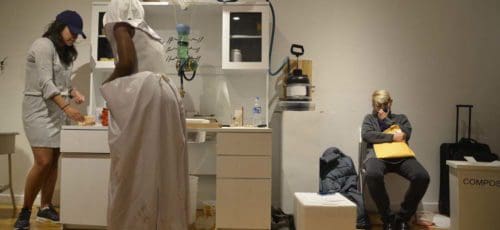Talkin’ Lights With Maria Shaplin
“I learned how to make the most out of twelve lights. It was the best possible lighting education.”
Philadelphia-based lighting designer Maria Shaplin has just finished a (second) run of Vainglorious with her company Applied Mechanics as part of PIFA. (You may have noticed a lot of photos of folks in Napoleonic outfits on PIFA promotional materials—all pretty much courtesy of Vainglorious!) This September she will be the lighting designer for The Ballad of Joe Hill, which Swim Pony Performing Arts is remounting and reimagining for the 2013 FringeArts Festival. Like the 2006 original, Joe Hill will be performed in Eastern State Penitentiary.
With a soft spot for new, experimental work, Maria is a member and resident lighting designer for The Riot Group and cofounder and resident production designer for Applied Mechanics. Chances are if you get out at all you have seen her work, which has included gigs with New Paradise Laboratories, The Berserker Residents, Lucidity Suitcase Intercontinental, Theatre Exile, and The Philadelphia Shakespeare Theatre, and many others.
FringeArts: Where did you grow up and what was it like?
Maria Shaplin: I was raised in Burlington, Vermont. It is a small city with a thriving arts community. It’s a strange mix with a cold New England isolationist attitude, while we take things like recycling, organic food, and jam bands VERY seriously. For instance, it is perfectly acceptable to ignore someone you know quite well if you see them on the street. Even if you are the ONLY TWO PEOPLE ON THE STREET! I think there is an intense respect for other people’s personal headspace there. But when Jerry Garcia died it felt like the whole city was in mourning for a week, and City Hall Park turned into a public art project/love-in. Art, music, drugs, all-wheel drive, sensible shoes, and a working knowledge of how to build a good fire—these are all very important in Vermont.
FringeArts: What got you into lighting design? Were you on crew in high school? At what point did you turn from the functional to an artistic approach?
Maria Shaplin: I was in show chorus in middle school (two decades before Glee made it cool). I messed up a solo in a country music review show—totally mortified—forgot two whole verses to “I Was Raised on Country Sunshine” whilst dressed in pleather and fringe. Unrecoverable humiliation. Never went on stage again. The next day I joined set crew and never looked back. In high school I was the stage manager, ordering around a crew of young misfits, and also building sets after school. I was running sound for a community theater as well.
Theater was always extra-curricular for me. I never thought people actually had a career in theatre. But the real turning point was in college. My brother [Adriano Shaplin of The Riot Group] started writing plays and touring them to the Edinburgh Fringe Festival in the summer. He would alternately take my sister and I each year. It happened that the second year I went, his third play at the festival, we won all the fringe awards and got picked up by a touring producer. It really was the theater dream—we were NOBODY, and we used to put “Five Stars from the Scotsman” on our posters when in fact we had never even been reviewed. But then we actually GOT five stars, and we were touring on a world stage. In 2000 we had a month-run in London, and then the next play in late 2001 and 2002, we toured all over England, and had dates in Germany and New York and San Francisco. I was the sound and light board operator, but on tour we were cutting costs and our British technical director was like, “You are learning how to do a light plot so you can help me, goddamnit.”
So gradually I learned how to do all that stuff myself and became the lighting director. When it’s your job to reset that stuff, you start to care, and take pride in how it looks. I started being able to make it look better and better. I had a bare bones approach. I learned how to make the most out of twelve lights. It was the best possible lighting education: to have so few tools to make something look gorgeous, to learn a different lighting board, and to use different types of units in every town.
FringeArts: Given a show to create the lighting design for—what are your first steps?
Maria Shaplin: Immersion in the material, and research. If it’s an existing play, read it, watch all the movie and TV versions (I don’t consider that cheating), and pick the director’s brain about their vision. Then pull a bunch of research images, organize and often collage them into the color pallet, and texture proposals for the show. If it’s a devised work, then I will immerse myself in the dramaturgy, the process, and the brains of the other generative artists and performers. Because I work on more and more devised work these days, it’s incredibly important to be in rehearsal if I am able to.
Getting to know the stage or space is also very important. If it’s a normal theater I will spend a LOT of time inside the Vectorworks looking at hanging positions and angles. If it’s a found space, much of my brain space is dedicated to figuring out how I can make beautiful light looks without importing all of the trappings of a regular theater. If I’m in a warehouse, the LAST thing I want to see is a theatrical lighting unit.
FringeArts: How do you keep yourself from not repeating yourself?
Maria Shaplin: I probably do repeat myself at times. I have favorite colors that I just crave, and can’t help myself from using over and over again. But in general, yes there is so much variety, it’s amazing and maddening. I often take creative risks, which sometimes pay off, and often totally fail.
Someone once asked me, “Why don’t’ you use the McCandless Method of lighting design?” Well, first of all, very few theaters I work in have enough units or dimmers to use that method, but also, why would you use so many dimmers for ONE IDEA? I want to have a ton of ideas up there, and let the differences between them surprise and delight me.
I am not precious about anything, and I’m very self-critical. I never think that anything I do is good enough so I’m always trying to improve upon the last. I think I’m an anxious and dissatisfied artist, and one of the reasons I love theater is that after a few weeks we get to tear it all down and start from scratch again. I love throwing things away, and getting rid of things that aren’t cool anymore!
FringeArts: With most productions not having adequate tech time, how often do you think, fuck, I’d like to change that while the show is in its run?
Maria Shaplin: I never want to change things after opening! I want to run away and never see the show again!! By the end of tech I am often totally sick of looking at it. But I do change things dramatically during tech and previews. In my mind “work fills the time allotted” and if you schedule four hours of tech time, you get a show that LOOKS like it had four hours of tech time. But hopefully we will have all done enough homework and prep so that we did the best with those four hours that we possibly could. I do have regrets about bad choices in shows, but I know that I often see things that nobody else does, so I take comfort in the fact that if the director signed off on it before we opened, then it’s good enough. But if it’s a really bad show, there is usually a lot of other stuff wrong with it besides the lights.
FringeArts: You will be working on The Ballad of Joe Hill in September which is at Eastern State Penitentiary. What are some of the challenges and what are you looking forward to playing with?
Maria Shaplin: From what I hear we have to be incredibly low impact—very few lights can remain set up between performances when the prison is open to the public. That means the design has to be portable, durable, not look like cheesy theater lights, be incorporated into the scenic look of the show and functionally light the actors. Oh, and be innovative and offer surprise and delight. These are all really fun problems that I’m sure I will solve with precision and perfection and sarcasm.
FringeArts: What is your best-case scenario when working with directors/other main collaborators on a production? What do you want from them?
Maria Shaplin: I like to work with directors of all kinds, and I actually often get along well with auteur directors who have tantrums and yell at me. I yell right back. I enjoy a passionate director, even if they have conflicting ideas or are difficult. If they are doing really cool work, conceptual, risky, or stylistically experimental work, I will put up with a lot. Or directors that use evocative language to describe what they want, and leave the logistical choices up to me. Like a director recently said, “I want us to feel as though Iago is infecting each scene with his poison” I LOVE that.
The thing I hate: I’ve been in rooms where directors are very prescriptive, and tell me exactly how they want the scene to look, like “Well, Maria, in my mind this scene is late-afternoon early evening in the southern United States, on a shady farm, so the sun would be setting to the west through the willow trees, and you should probably use that light right there.”
FringeArts: When working on shows in your own company, Applied Mechanics, what can you do/explore that doesn’t happen elsewhere when working?
Maria Shaplin: With Applied Mechanics I’m often present at the inception of an idea, and so I often get to make choices about the physical world of the play very early on. I also get to chose my design role based on what I think the show needs. So for instance, for the last two shows I have done mostly sets, costumes, or sound. It’s my chance to play in these other areas, and it’s hard to switch gears but good for me as an artist. I rarely make more than five lighting cues for an App Mech show, because with immersive and parallel narrative work, there is already so much going on in so many places, you have to keep it in a fairly static look so that the audience can maintain their bearings.
FringeArts: You recently finished up the second run of Vainglorious, how’d it go?
Maria Shaplin: AMAZING. I usually hate remounting shows, but this one basically went off without a hitch. We got great reviews, were in American Theatre Magazine, had the most brilliant cast, and had a very warm and fulfilling dedication of the piece to Reuben [Mitchell]. Watching actors perform the choreography that he created a year ago, it was very emotional and cathartic. We were so proud of the show, but last year so few people saw it, we saw this PIFA gig as a chance for more folks to see what we are up to, and it all worked out great.
Thank you, Maria!
Check out Maria’s website mariashaplin.com and you too can steal all her lighting ideas!
–Josh McIlvain







